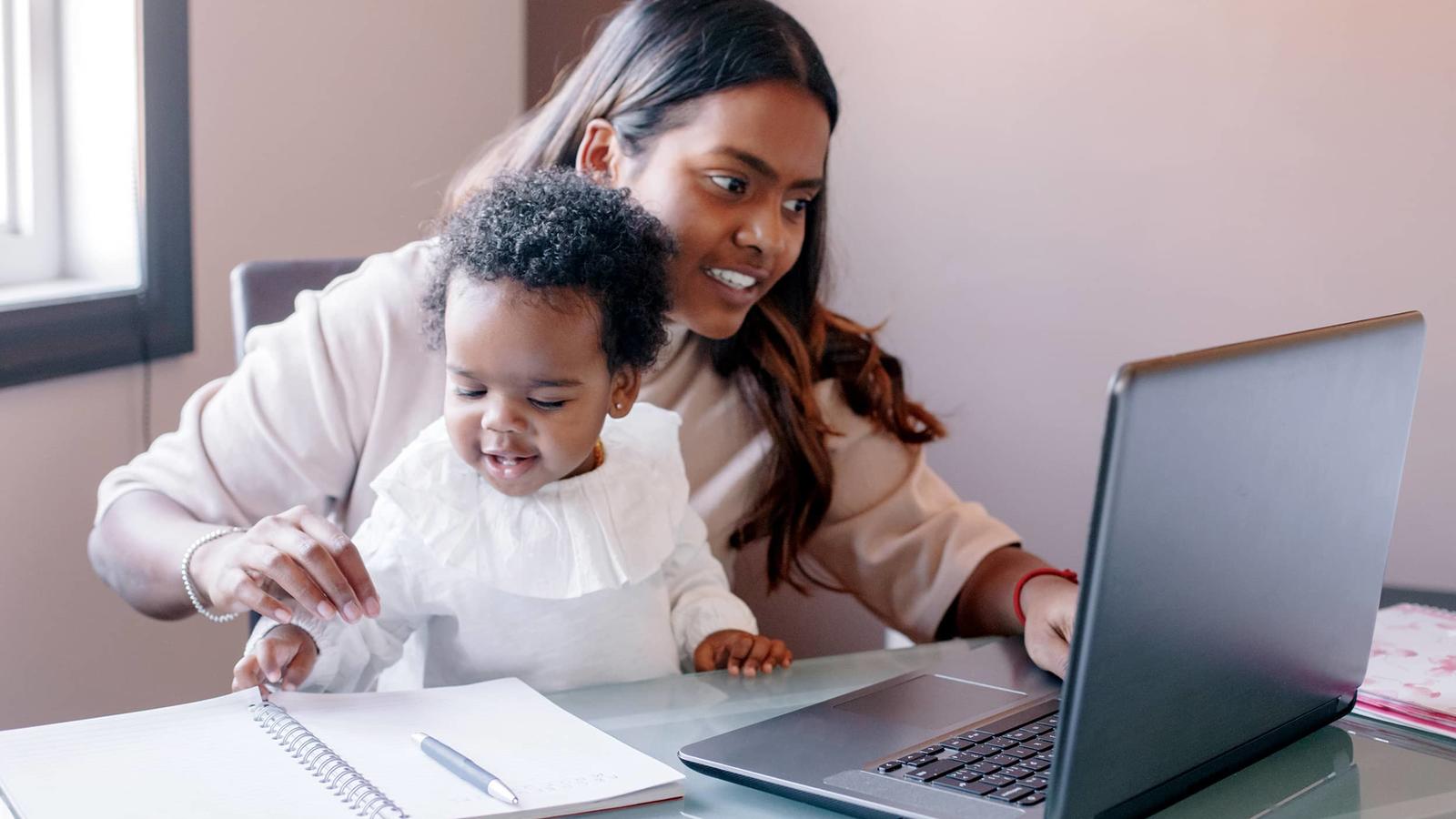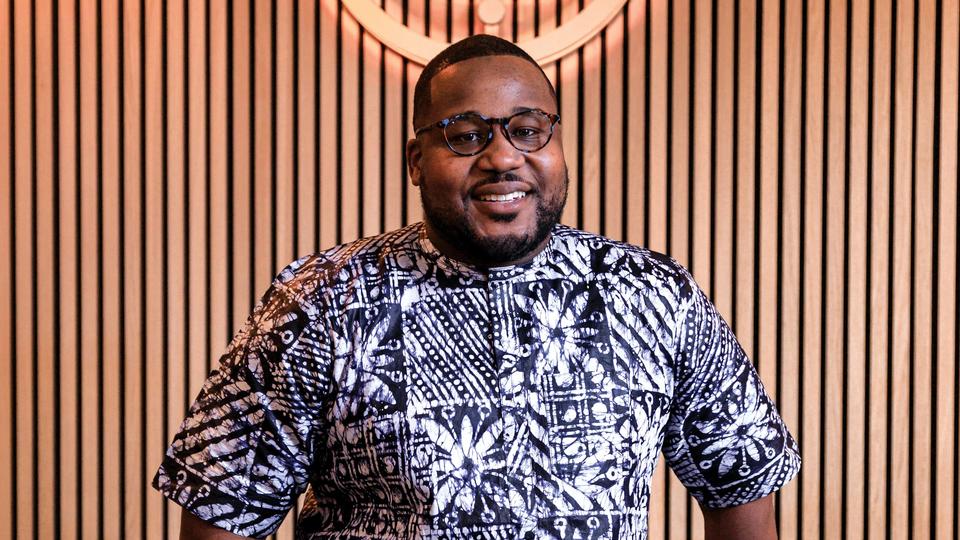
The Way We Work

The pandemic turned the 9-to-5 office work model on its head — and caused record numbers of people to re-evaluate their approach to work altogether.
Before the pandemic, Scott Gale ’19 dressed in a suit and spent up to seven hours a week commuting to and from his global strategy job at Halliburton headquarters north of Houston. Every quarter, he jetted off to far-flung destinations like Argentina, Brazil and Saudi Arabia.
His hectic schedule left little time for self-care or for quality time with his wife, Nicole, and their four kids. “I had a bad joke that I never saw my house in the light of day,” Gale says. “I was out before the sun came up and back after it went down. It was a grind.”
Then, in early 2020, at 36, Gale was diagnosed with colon cancer. He started chemotherapy as the world went on lockdown and transitioned to remote work. Not long afterward, he took on a new role creating an energy accelerator for Halliburton, bringing together investors, startups, industry leaders and academics. It was a feat he says wouldn’t have been possible to complete so quickly without the ability to work from home.
“Remote work has been an absolute shelter through this storm,” Gale says. “This can’t be understated: It’s enabled me to bring my whole self to what I do.” Now, he can’t imagine returning to a traditional, in-office 9-to-5, even after the pandemic subsides.
The pandemic upended the work lives of countless executives like Gale, changing their perception of what work should be and how they want to do their jobs. Some shifted to work-from-home out of necessity during the height of COVID but found that they relish the benefits — from money saved without a commute to more time with family. According to the freelancing platform Upwork, employees who work remotely save an average of 51 minutes a day.
“The pandemic is a moment of reflection and consideration,” says Scott Sonenshein, the Henry Gardiner Symonds Professor of Management at Rice Business. “We’ve seen the empowerment of the worker and the recognition that the standard 9-to-5 schedule is passé.”
Now, more than 50% of employees say they want to work remotely at least three days a week, according to a recent PwC study, and 52% of men and 60% of women say they’ll quit a job if they can’t work remotely, according to FlexJobs. By 2025, the number of remote workers is expected to double from pre-pandemic levels, from 16.8 million Americans to 36.2 million.
Meanwhile, online searches for remote roles across industries jumped 360% from June 2019 to June 2021, according to the job search engine Glassdoor. This acceleration will add to what was already a growing trend: Over the last 12 years pre-COVID, remote work had seen 159% growth, according to McKinsey.
Working Smarter and Faster
For Gale, who’s now the executive director of engagement at Halliburton Labs, the transition to remote work was smooth. His first job out of college was as a work-from-home account representative for Dow Chemical, and the company put workers through remote work training.
“They taught us best practices, and I was able to dust those off the shelf,” Gale says.
When Halliburton’s CEO asked Gale if he would develop the energy accelerator, Gale jumped at the chance to build something exciting and new, a welcome distraction from his cancer treatment.
“If I’d been asked to do that job the year before, I would have been on a plane to San Francisco and Boston to understand the startup community and meet people,” Gale says. But during the pandemic, he met people over video instead, speeding up the process.
It took him a mere three months to make the connections he needed to build out the accelerator. He started the new job on June 1 and had an advisory board less than two months later.
“Work-from-home massively accelerated what we were trying to do,” Gale says. “Managing my own time and schedule made a huge difference.”
Now, the accelerator has seven employees. Nearly 40 companies have pitched projects across four events, and 12 were selected to participate in a 12-month “scalerator” experience.
At the same time, Gale gained valuable time with family. He started biking with his kids to school and often picks them up at the end of the day. He’s taught his now fifth-grade daughter how to play basketball, took his seventh grader to cross-country practice every week last fall, and spent time playing video games with his kindergartener son.
“I went from never seeing my home in the light of day to stepping out of my office and having lunch with the kids,” he says. “I termed it as reintroducing myself to my family.”
New Career Paths
The pandemic also changed the way Brian Jackson ’21 approached his work.
When COVID first gained a foothold in the U.S., Jackson was working as a litigator at a small Texas oil and gas law firm, where he donned a sport coat and commuted daily to the office. He often spent long hours away from home — and his partner and their dog.
“I used to believe that being the first car parked in the lot at the office meant you were a good or even the best employee,” says Jackson, who now lives in Boston.
In the fall of 2020, the law firm let him go as clients scaled back projects, and he took a remote role working as a contract manager at renewable energy company Enel Green Power. No longer does he have to dress up or slog through a long commute. He’s enjoying his time at home working alongside his partner, who’s in hybrid dental school.
“My life shifted to being present with the people and dog I love,” Jackson says. “Now, I believe that having a workplace that cares about your individual need to balance career and home matters. Without the pandemic, I wouldn’t have shifted to a new career and would not have grown to know a culture that supports me.”
According to a Pew Research study, Jackson isn’t alone. Nearly 40% of new remote workers say it’s now easier to balance work with family obligations.
In Seattle, Michael Scott ’05 also relishes the extra personal time remote work makes possible. Scott and his family of four moved from Austin to Seattle in the fall of 2018 after Expedia acquired the company he was working for, HomeAway.
At the time, Expedia was building a new headquarters on the Seattle waterfront. Scott moved to the new facility in November 2019, only to be sent home months later to work remotely because of COVID. At the same time, travel screeched to a halt. Scott’s team, which was responsible for managing cash and liquidity, worked day and night rebuilding forecasts and working through worst-case scenarios.
“It was incredibly stressful and burned out many people on the team,” he says.
At first Scott and his laptop bounced around the house, from the kitchen table to a card table in the bedroom. When it became clear that COVID wasn’t going away, he bought a desk and set up a work station in the basement. In March 2021, he joined Rice Business alum Jason Sanders ’15 at Fastly, taking a fully remote job as senior director of treasury.
Now, Scott is treasurer at Dropbox, a remote-first company. Among other perks of working from home: He walks his dog three times a day. “The dog is the biggest winner here,” he says. He also likes that his family could pick up and move again to a new city if they wanted to. “Remote work has really opened up options,” he says.
Yet at the same time, Scott misses being with colleagues in a shared workspace and the camaraderie and spontaneous, informal interactions that happen in offices, especially with projects that require back-and-forth or deep conversation. “There’s still not a good way to replicate that,” he says.
Keeping the Culture Alive
As CEO and president of the branding agency Savage Brands, Bethany Andell ’01 has worked throughout the pandemic to strike the right balance between safety and flexibility, culture and connection.
Pre-pandemic, her Houston employees were 9-to-5ers. “We were not used to a remote or hybrid workforce,” she says. She shut down the office in March, an easy transition since her employees work on laptops and already had video conferencing capabilities. Workers were able to take their computer monitor and desk chairs home with them.
“What was different, though, was that we didn’t necessarily understand how and when to connect with each other unless we were specifically working on a project,” says Andell.
She’s felt detached from what her teams were working on, despite weekly leadership Zoom meetings and all-staff Zooms. But she’s constantly trying new techniques. On a Zoom call after New Year’s Day, employees took turns setting a one-word intention for the year.

For Martin Luther King Day, an all-staff Zoom featured a video of King’s “I Have a Dream” speech. She also recently asked a new employee to give a 15-minute Zoom talk about himself, and on Fridays she hosts a Zoom coffee hour for anyone who wants to catch up.
Now Andell has cut her company’s office space in half and is moving to a hybrid “hoteling” model, where employees come in a few times a week to use an open desk. “I don’t care what time or how long they stay,” Andell says. “I just want to start encouraging people to meet in person,” especially for brainstorming or collaborations.
About a third of chief operating officers plan to reduce their companies’ office space, according to McKinsey. And while working remotely has benefits for workers, this could also benefit the planet. The average remote worker lowers their carbon footprint by around 1,800 pounds of greenhouse gas emissions by working from home, according to a report from Alliance Virtual Offices.
“We’ve become much more flexible in our thinking about talent and where people live,” Andell adds, noting that one employee moved to Washington State. For her own part, Andell enjoys working from home and finds she works harder without as many in-person interruptions. But there are drawbacks.
Sometimes she has trouble separating the work day from personal time. She’s lost her “liminal space,” she says, or the transition from work to home, which used to be her commute. “I’ve had to manufacture that transition,” she says. Some days, it’s a glass of wine that demarcates the workday from downtime at home.
Gale, too, has increasingly noticed the boundaries blurring between work and home, as have around a third of people working remotely, who say they’re working more hours now than they were before the pandemic, according to Pew.
Gale’s strategy has been to block off his calendar for key events like cancer treatment and family activities. He also uses the delay delivery feature in email, scheduling messages to go out in the morning rather than sending them at night. He doesn’t want employees to feel compelled to respond after hours because he’s emailing when his schedule permits.
In January, Halliburton began reopening its Houston campus, encouraging employees to come into the office several days each month. Gale appreciates the opportunities for colleagues to collide, which he agrees is hard to mimic virtually. But still, he prefers to maintain control over his schedule.
“It’s the flexibility that’s been fantastic,” he says. “It’s had a huge impact on our quality of life. It really has been a silver lining during the pandemic.”
Sonenshein acknowledges that, while some tasks are better done quietly at home, people are indeed longing for connection. “You do need that in-person interaction at least part of the time to build up camaraderie,” he says. “What we’re going to see is a blended approach. Hybrid work is here to stay for the foreseeable future.”


